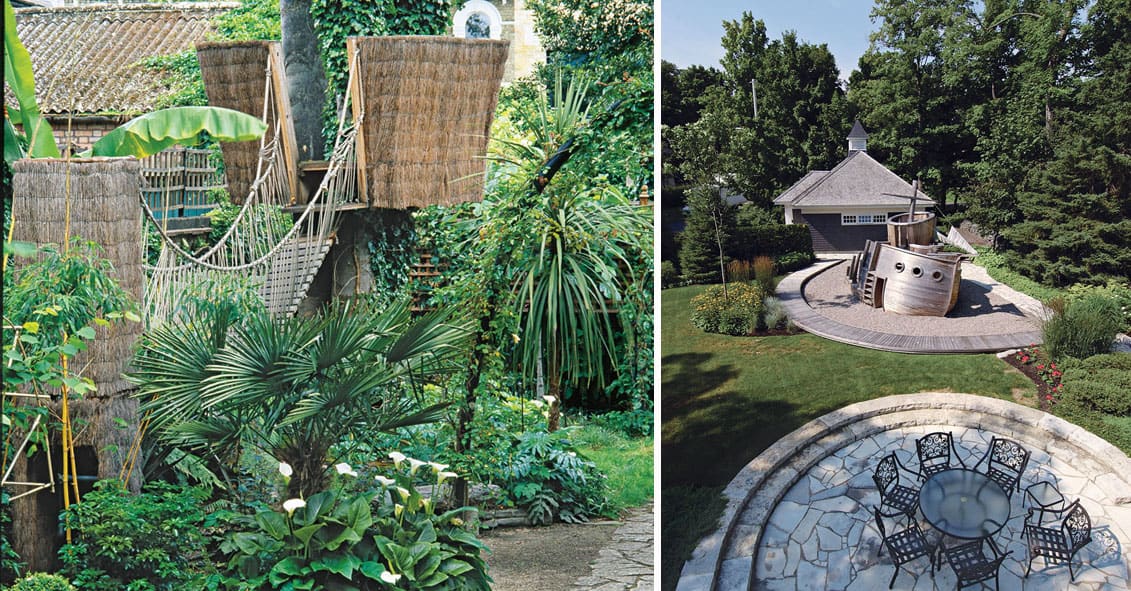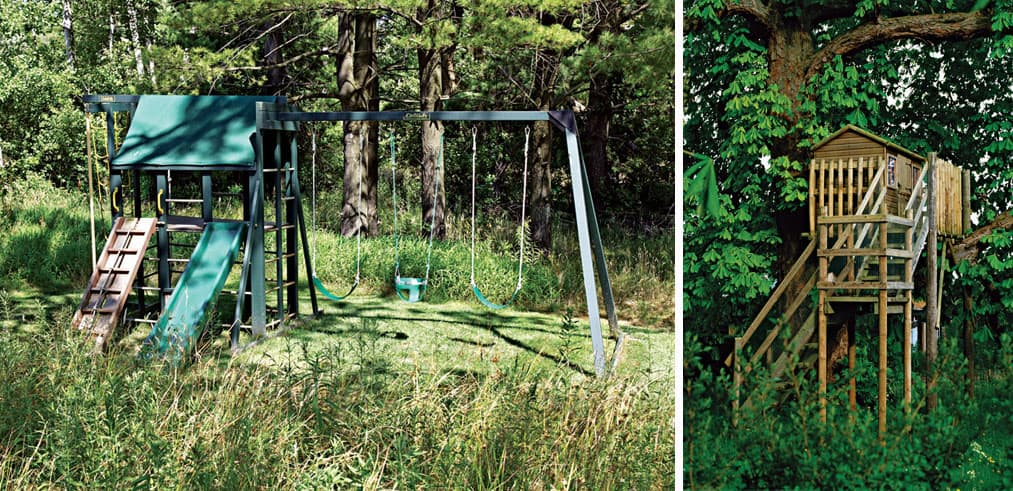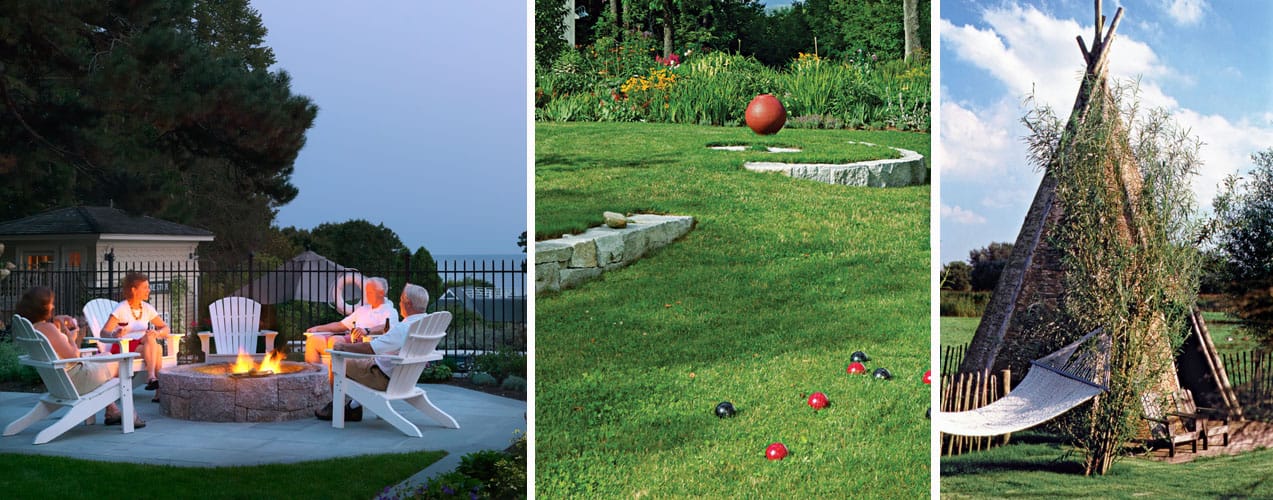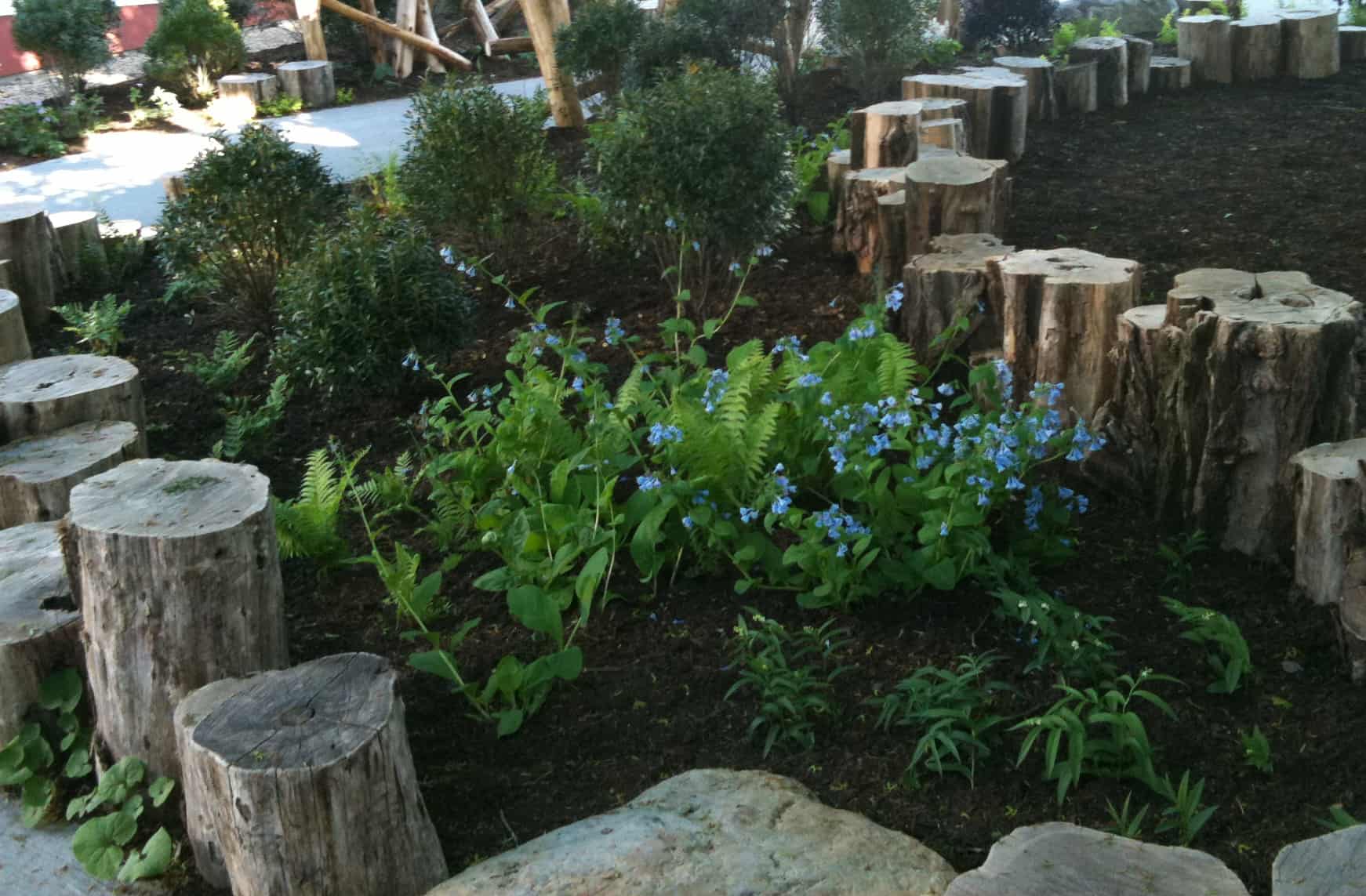By Jennifer Silver, JMMDS
In a recent article in the Wall Street Journal about landscaping for kids, Anne Marie Chaker writes about the demand for playscapes and play equipment that won’t be “hulking eyesores” in the garden, yet will challenge and entertain children over the long term. Some parents and designers solve this problem in creative and imaginative ways, with zip lines, climbing walls, and more—but with a price tag way out of reach for many homeowners.
Although unquestionably fantastic, elaborate playscapes like these are not attainable or desirable for everyone. Left: Photo by Nicola Browne, design by Evan English. Right: Photo by Roy Grogan, design by John Szczepaniak. Both images from Home Outside: Creating the Landscape You Love by Julie Moir Messervy.
Recently Julie was interviewed by Real Estate Today about creative landscaping for families with children. (Listen to the entire interview here.) Real Estate Today’s Gil Gross asked Julie about the new high-tech outdoor playscapes for children.
Left: Children’s favorite places are not right under our noses; they want to “see but not feel seen,” according to Julie. Photo by Charles McCullough from Home Outside: Creating the Landscape You Love. Right: This design by JMMDS’s Home Outside online service gives children open space for active play, as well as a private corner under the trees tucked behind the picket fence. Photo by Susan Teare.
These elaborate and expensive playscapes can be fun, says Julie, but they’re not necessary. She always starts by asking clients and stakeholders to think about their own favorite childhood spaces and daydreaming places. These spaces are invariably high in a tree, under an overgrown shrub, wading in a stream, digging in a corner of the yard. Kids love tree stumps (remember how Laura and Mary Ingalls played with them?), stepping-stones, and old-fashioned water hand-pumps. It’s important not to keep the garden too perfectly manicured, and it’s just not essential to spend a lot of money.
Children cannot resist water! Left: The hand-pump at Hidden Hollow. Right: Saying hello to the koi at Weezie’s Garden at Elm Bank. Photos and designs: JMMDS.
We have learned a lot about safety in recent years, and it is a good idea to incorporate this information into our home landscapes. Parents can enclose play spaces with a wall or hedge, remove standing water that encourages mosquito infestations, provide shade from midday sun, and create safe surfaces to prevent injuries from falls (which amount to about 70% of playground injuries).
Recycled rubber surfaces are increasingly being used in public playgrounds, but homeowners tend to prefer more natural-looking materials, for obvious reasons. Wood bark mulch is an appropriately soft landing cushion for adventurous climbers, but it often compacts over time and fails to drain properly; standing water can become a nuisance. Sand and pea-gravel make good loose-fill surfaces; just make sure to provide some type of edging so the mulch doesn’t travel into your lawn.
Left: The classic wooden “jungle gym” is often loved and used to the point of disintegration. The slightly wild character of this yard suits it perfectly. Photo by Randy O’Rourke; design by Salsbury-Schweyer, Inc. Right: This vertical play structure is a good alternative for a small yard. Photo by Nicola Browne; design by Blackenham Wood. Both images from Home Outside: Creating the Landscape You Love.
It’s important, too, to create outdoor spaces that children and adults alike can enjoy, such as fire pits, hammocks, vegetable gardens, etc.—all of which are places that will still be appreciated when the children outgrow their swings and climbing structures.
Some landscape features that are fun for all ages: fire pits, lawn games, hammocks, and teepees. L: Design by JMMDS; photo by Susan Teare, from Landscaping Ideas That Work. C: Bocce court design by JMMDS; photo by Randy O’Rourke from Home Outside: Creating the Landscape You Love. R: Hammock and teepee; design by Piet Oudolf; photo by Nicola Browne, from Home Outside: Creating the Landscape You Love.
Creating children’s gardens is some of the most rewarding work we do at JMMDS. Each of our gardens—whether for a residence, school, museum, or botanical garden—is unique, but they all feature low-tech natural materials, often recycled or locally sourced. There is nothing as gratifying as hearing that visitors return again and again to these gardens because the children never tire of them, while the parents feel restored and revitalized by the beautiful surroundings. Your own yard can be just such a place—where children play safely and imaginatively while you reap the benefits of nature, too.
JMMDS’s Inspiration Garden at Shore Country Day School features a concrete and glass “whirlpool” that children love gazing into; creating it was a balancing act! Photos: JMMDS.
The current issue of Public Garden magazine features an article by Julie called “Growing the Imagination,” about JMMDS’s children’s gardens, all of which offer myriad opportunities for imaginative play in nature. See the article PDF here: Public Garden Spring 2014.













